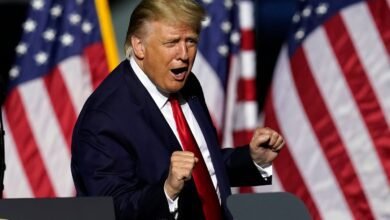While celebrating the January 6th protesters, Trump also celebrates January 6th

“Sir, they cut it because they are rioting at the Capitol,” the valet explained, according to his statement. Trump momentarily didn’t get it, and then he did.
“Oh, really,” he said, according to the valet. “And then he said, ‘Okay, let’s see.’”
“For hours, he watched the attack on his TV screen,” the committee’s final report explained. “His favorite channel was Fox News. He issued a few tweets, some of his own volition and others only at the repeated request of his daughter and other trusted advisors. He made several phone calls, some to his personal lawyer, Rudolph Giuliani, others to members of Congress about continuing his objections to election certification, even though the attack was well underway.”
One member of Congress he spoke with was House Minority Leader Kevin McCarthy (R-Calif.). McCarthy pressured him to release a statement forcefully calling for the protesters to withdraw. At first, according to Rep. Jaime Herrera Beutler (R-Wash.) (who was briefed on the call), Trump argued that the protesters were not his supporters but, instead, left-wing agitators. McCarthy – who saw firsthand that this was not true – rejected the idea.
“Well, Kevin,” Trump responded, “I think they’re just more upset about the election, you know, about the theft than you are.”
Details that have emerged about the hours Trump spent watching the attack suggest he supported it. His chief of staff, Mark Meadows, reportedly told a Trump lawyer that the president “doesn’t think they’re doing anything wrong.” When Trump finally called on protesters to leave the Capitol, he did so with words of encouragement: “Go home, we love you. You are very special.”
Immediately after the riot, there was no political space for Trump to offer his endorsement. He was widely condemned and his effort to subvert the election results failed. He lost access to major social media platforms and was relegated to the sidelines.
But partisan hostility is a powerful thing, and others on the right have begun using the riot not as a way to support Trump but to criticize his successor, Joe Biden. Those detained for participating in the violence were classified as political prisoners or martyrs. The idea that the violence was the function of left-wing or government-backed agitators gained traction. When Trump announced his candidacy for the 2024 nomination, he had already begun embracing protesters – often called “J6 prisoners” – often describing them as victims. After all, his campaign was oriented around the idea that he, too, was the victim of overzealous partisan law enforcement. The protesters he watched approvingly on January 6 were now comrades in arms.
Over the weekend, Trump spoke at a rally in Las Vegas. There, he offered his strongest support to the protesters, a group he has previously promised to forgive.
“There have never been people treated more horribly than the J6 hostages,” Trump said. A little later, he added that “they were warriors, but in fact, more than anything else, they are victims of what happened.” After all, he said, they were encouraged to enter the building by police or shadowy figures linked to the government – common rhetoric from the fringes that sharply conflicts with the evidence of what happened that day.
There is obvious utility in Trump’s message that the administration is out to target right-wing Americans — and, by extension, that his accusations are baseless and political. But considering the January 6 protesters as victims and/or heroes also seems to better reflect how Trump considered the violence at the time. He said he loved them even when the riot was underway.
At times in the years since, he has tried to foster similar displays of support. When an indictment was imminent in New York City in early 2023, he demanded that his supporters show up in force.
“THE LEADING REPUBLICAN LEADER AND FORMER PRESIDENT OF THE UNITED STATES OF AMERICA, WILL BE ARRESTED ON TUESDAY NEXT WEEK,” he wrote on social media at the time. “PROTEST, RETURN OUR NATION!”
No such protests emerged, not even when he suggested that people show up in Miami at a time when he was facing a federal indictment in that city. As his Manhattan trial unfolded and neared its conclusion, he repeatedly stated that protesters were kept away from the courtroom (perhaps to explain why no protests erupted), even as he demanded that, for example, his supporters “ GO OUT AND PROTEST PEACEFULLY. MEETING BEHIND MAGA. SAVE OUR COUNTRY!”
It makes sense that Trump would seek such a display. He has long drawn strength from shows of support: participation in rallies (which he often exaggerates), supporters outside the hospital where he was being treated for Covid-19, etc. that he would remain in power for hours on end! No wonder he kept waiting for protests to erupt again.
What his supporters have often done, instead of gathering in visible shows of support, is something less energy-intensive: sending threats to his opponents. Political scientist Donald Moynihan documented some of these efforts in an essay over the weekend, part of an outline of the way Trump has “normalized retribution as an appropriate scope of presidential action and the use of political power.”
Among other things, he looks at Trump’s response to the Capitol riot and the reaction of his supporters.
“Half of the judges who oversaw the January 6 trials reported increased threats and harassment,” Moynihan noted, “and the mother of a police officer attacked by protesters was beaten after the officer labeled Trump an authoritarian.”
The effect of Trump’s encouragement of this approach, he concludes, is to help embed it in American politics. However intentionally instituted, this expands his ability to leverage power should he return to the White House, ensuring he has ways to exert pressure outside of elections or the law.
Some of what Trump is doing here, however, may be simpler in intent. Trump likes attention, support and enthusiasm. At no point has he achieved more of this than on January 6, 2021, no matter how damaging it is to everyone else and to democracy. He understands the political value of treating the Jan. 6 protesters as victims. But his appreciation for their efforts is almost certainly of a more personal nature.
If this is detrimental to the nation, so be it.




